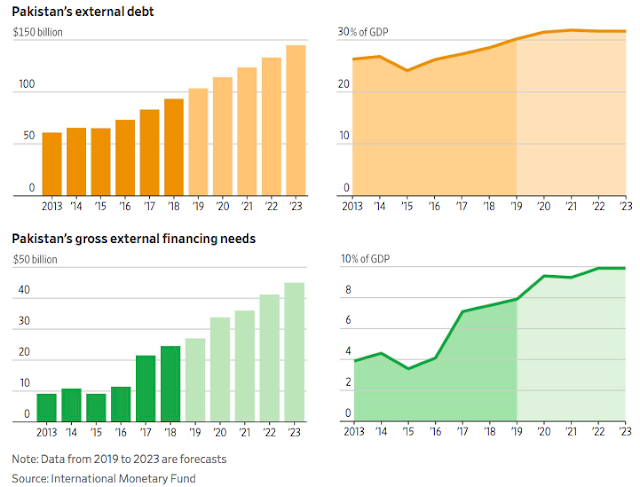PakAlumni Worldwide: The Global Social Network
The Global Social Network
PTI's New Economic Team Line-Up in Pakistan
Who are the members of Pakistan's top new economic leadership team? Who's Reza Baqir? Who's Shabbar Zaidi? Why were the changes necessary? Were the latest changes made to remove previous PMLN government's loyalists considered to be responsible for the current economic crisis? Did their policies and actions contribute to large twin deficits? Did the International Monetary Fund (IMF) force these changes as a condition for the country's bailout?
Pakistan's External Debt. Source: Wall Street Journal |
 |
| Pakistan Current Account Deficit. Source: State Bank of Pakistan |
As Pakistan awaits the news of the discovery of large offshore oil reserves, what lessons should Pakistan learn from the governance failures in Venezuela? Is Venezuela suffering because of its government's hostility toward the United States? Will large oil reserves be a panacea for Pakistan's economic problems?
Viewpoint From Overseas host Faraz Darvesh discusses these questions with Sabahat Ashraf (ifaqeer) and Riaz Haq (www.riazhaq.com)
Related Links:
Can Pakistan Avoid Recurring IMF Bailouts?
Expectation of Massive Offshore Oil Discovery in Pakistan
CPEC Financing: Is China Ripping Off Pakistan?
Information Tech Jobs Moving From India to Pakistan
Pakistan is 5th Largest Motorcycle Market
"Failed State" Pakistan Saw 22% Growth in Per Capita Income in Last...
Pakistan's $20 Billion Tourism Industry Boom
-
Comment by Riaz Haq on June 28, 2019 at 4:28pm
-
Fitch cuts growth for #Pakistan to 3.2% in FY2018/19 and 2.7% in FY19/20 with tighter monetary/fiscal policies. #CPEC will provide support to #economy. "Construction of many key CPEC projects has already started and will stretch over the coming years.” https://tribune.com.pk/story/2001719/2-fitch-chops-growth-forecast-...
Fitch Solutions, the US-based global research house, has revised down Pakistan’s economic growth forecast, believing tightening of monetary and fiscal policies under the International Monetary Fund (IMF) bailout would negatively impact GDP growth.
“We at Fitch Solutions, have revised our forecast for Pakistan’s real GDP (gross domestic product) growth for FY2018/19 (July-June) and FY19/20 to come in at 3.2% and 2.7% respectively, from 4.4% and 4.0% previously (versus the Bloomberg consensus of 3.3% and 3.5%),” the global research house said in a report on ‘Economic Analysis – IMF deal to weigh on Pakistan’s growth in the short run.’
“We believe that the bailout package from the IMF will see tighter monetary and fiscal policies in Pakistan, which will be negative for growth in the near term,” it said.
However, investment into the China-Pakistan Economic Corridor (CPEC) will continue to provide some support to the economy, it added.
After close to eight months of negotiations, Pakistan reached an agreement with the IMF in May for a $6 billion bailout package to address its balance of payment crisis. Following the agreement, the State Bank of Pakistan (SBP) increased the policy rate by 150bps.
Shortly after, the Ministry of Finance presented a budget in June with the aim of trimming Pakistan’s primary deficit to 0.6% of GDP in FY19/20, from 1.9% of GDP in FY18/19 according to the IMF’s estimates. “Given the tighter monetary and fiscal policies amid an already subdued economic growth outlook, we at Fitch Solutions have revised (down) our forecast for Pakistan’s real GDP growth,” it said.
Comment
- ‹ Previous
- 1
- 2
- Next ›
Twitter Feed
Live Traffic Feed
Sponsored Links
South Asia Investor Review
Investor Information Blog
Haq's Musings
Riaz Haq's Current Affairs Blog
Please Bookmark This Page!
Blog Posts
WIR 2026: Income and Wealth Inequality in India, Pakistan and the World
The top 1% of Indians own 40.1% of the nation's wealth, higher than the 37% global average. This makes India one of the world's most unequal countries, according to the World Inequality Report. By contrast, the top 1% own 24% of the country's wealth in Pakistan, and 23.9% in Bangladesh. Tiny groups of wealthy elites (top 1%) are using their money to buy mass media to manipulate public opinion for their own benefit. They are paying politicians for highly favorable laws and policies to further…
ContinuePosted by Riaz Haq on December 15, 2025 at 1:00pm — 2 Comments
Pakistan Gets its First AI Data Center
Data Vault and Telenor Pakistan have launched the nation's first dedicated AI data center in Karachi. It is designed to support startups, researchers, and government agencies with high-performance computing and GPU-as-a-service offerings. It is equipped with more than 3,000 Nvidia's highest performance H100 and H200 GPUs for which the Trump Administration issued export licenses. These GPUs cost from $40,000 to $60,000 each, making the Nvidia chips the biggest chunk of the investment…
ContinuePosted by Riaz Haq on December 10, 2025 at 11:00am — 2 Comments
© 2025 Created by Riaz Haq.
Powered by
![]()

You need to be a member of PakAlumni Worldwide: The Global Social Network to add comments!
Join PakAlumni Worldwide: The Global Social Network